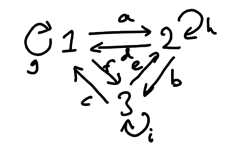Difference between revisions of "M(8,5,3)"
(Decomposition and Cartan corrected) |
(Added PIMs) |
||
| Line 1: | Line 1: | ||
{{blockbox | {{blockbox | ||
|title = M(8,5,3) - <math>k(A_4 \times C_2)</math> | |title = M(8,5,3) - <math>k(A_4 \times C_2)</math> | ||
| − | |image = | + | |image = M(8,5,3)quiver.png |
|representative = <math>k(A_4 \times C_2)</math> | |representative = <math>k(A_4 \times C_2)</math> | ||
|defect = [[C2xC2xC2|<math>C_2 \times C_2 \times C_2</math>]] | |defect = [[C2xC2xC2|<math>C_2 \times C_2 \times C_2</math>]] | ||
| Line 52: | Line 52: | ||
== Projective indecomposable modules == | == Projective indecomposable modules == | ||
| + | Labelling the simple <math>B</math>-modules by <math>S_1, S_2, S_3</math>, the projective indecomposable modules have Loewy structure as follows: | ||
| + | <math>\begin{array}{ccc} | ||
| + | \begin{array}{ccc} | ||
| + | & S_1 & \\ | ||
| + | S_1 & S_2 & S_3 \\ | ||
| + | S_2 & S_3 & S_1 \\ | ||
| + | & S_1 & \\ | ||
| + | \end{array}, | ||
| + | & | ||
| + | \begin{array}{ccc} | ||
| + | & S_2 & \\ | ||
| + | S_1 & S_3 & S_2 \\ | ||
| + | S_2 & S_1 & S_3 \\ | ||
| + | & S_2 & \\ | ||
| + | \end{array}, | ||
| + | & | ||
| + | \begin{array}{ccc} | ||
| + | & S_3 & \\ | ||
| + | S_1 & S_2 & S_3 \\ | ||
| + | S_3 & S_1 & S_2 \\ | ||
| + | & S_3 & \\ | ||
| + | \end{array} | ||
| + | \end{array} | ||
| + | </math> | ||
== Irreducible characters == | == Irreducible characters == | ||
Revision as of 09:39, 9 September 2018
| Representative: | [math]k(A_4 \times C_2)[/math] |
|---|---|
| Defect groups: | [math]C_2 \times C_2 \times C_2[/math] |
| Inertial quotients: | [math]1[/math] |
| [math]k(B)=[/math] | 8 |
| [math]l(B)=[/math] | 3 |
| [math]{\rm mf}_k(B)=[/math] | 1 |
| [math]{\rm Pic}_k(B)=[/math] | |
| Cartan matrix: | [math]\left( \begin{array}{ccc} 4 & 2 & 2 \\ 2 & 4 & 2 \\ 2 & 2 & 4 \\ \end{array} \right)[/math] |
| Defect group Morita invariant? | Yes |
| Inertial quotient Morita invariant? | Yes |
| [math]\mathcal{O}[/math]-Morita classes known? | Yes |
| [math]\mathcal{O}[/math]-Morita classes: | [math]\mathcal{O} (A_4 \times C_2)[/math] |
| Decomposition matrices: | [math]\left( \begin{array}{ccc} 1 & 0 & 0 \\ 1 & 0 & 0 \\ 0 & 1 & 0 \\ 0 & 1 & 0 \\ 0 & 0 & 1 \\ 0 & 0 & 1 \\ 1 & 1 & 1 \\ 1 & 1 & 1 \\ \end{array}\right)[/math] |
| [math]{\rm mf}_\mathcal{O}(B)=[/math] | 1 |
| [math]{\rm Pic}_{\mathcal{O}}(B)=[/math] | |
| [math]PI(B)=[/math] | {{{PIgroup}}} |
| Source algebras known? | No |
| Source algebra reps: | |
| [math]k[/math]-derived equiv. classes known? | Yes |
| [math]k[/math]-derived equivalent to: | M(8,5,2) |
| [math]\mathcal{O}[/math]-derived equiv. classes known? | Yes |
| [math]p'[/math]-index covering blocks: | {{{coveringblocks}}} |
| [math]p'[/math]-index covered blocks: | {{{coveredblocks}}} |
| Index [math]p[/math] covering blocks: | {{{pcoveringblocks}}} |
Contents
Basic algebra
Quiver: a:<1,2>, b:<2,3>, c:<3,1>, d:<2,1>, e:<3,2>, f: <1,3>, g:<1,1>, h:<2,2>, i:<3,3>
Relations w.r.t. [math]k[/math]: ab=bc=ca=0, df=fe=ed=0, ad=fc, be=da, cf=eb, g^2=h^2=i^2=0, ah=ga, bi=hb, cg=ic, dg=hd, eh=ie, fi=gf
Other notatable representatives
Covering blocks and covered blocks
Projective indecomposable modules
Labelling the simple [math]B[/math]-modules by [math]S_1, S_2, S_3[/math], the projective indecomposable modules have Loewy structure as follows:
[math]\begin{array}{ccc} \begin{array}{ccc} & S_1 & \\ S_1 & S_2 & S_3 \\ S_2 & S_3 & S_1 \\ & S_1 & \\ \end{array}, & \begin{array}{ccc} & S_2 & \\ S_1 & S_3 & S_2 \\ S_2 & S_1 & S_3 \\ & S_2 & \\ \end{array}, & \begin{array}{ccc} & S_3 & \\ S_1 & S_2 & S_3 \\ S_3 & S_1 & S_2 \\ & S_3 & \\ \end{array} \end{array} [/math]
Irreducible characters
All irreducible characters have height zero.
